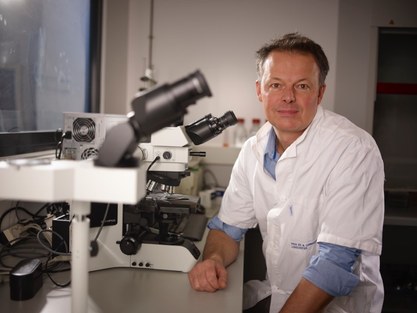Bart Lambrecht - ASTHMACRYSTALCLEAR
Description of the PI

The thematic area of his group is centered around unraveling the role of antigen presenting dendritic cells (DC) and epithelial cells in the lungs in asthma and viral infection. His theories on the mechanisms of allergic sensitization are now the basis of many research efforts across the globe, and offer prospects for the design of new preventive and therapeutic avenues for asthma. Still active as a clinician, Lambrecht is the example of a physician-scientist that can push the boundaries of basic science on asthma.
Contact: Bart.Lambrecht@ugent.be; Bart.Lambrecht@irc.vib-ugent.be
Publications: https://biblio.ugent.be/person/801000968239
Role of protein crystallization in type 2 immunity and asthma (ASTHMACRYSTALCLEAR)
Spontaneous protein crystallization is a rare event in biology. Eosinophilic inflammation such as seen in the airways in asthma, chronic rhinosinusitis and helminth infection is however accompanied by accumulation of large amounts of extracellular Charcot-Leyden crystals. These are made of Galectin-10, a protein of unknown function produced by eosinophils, hallmark cells of type 2 immunity. In mice, eosinophilic inflammation is also accompanied by protein crystal build up, composed of the chitinase-like proteins Ym1 and Ym2, produced by alternatively activated macrophages. Here we challenge the current view that these crystals are just markers of eosinophil demise or macrophages activation. We hypothesize that protein crystallization serves an active role in immunoregulation of type 2 immunity. On the one hand, crystallization might turn a harmless protein into a danger signal. On the other hand, crystallization might sequester and eliminate the physiological function of soluble Galectin-10 and Ym1, or prolong it via slow release elution. For full understanding, we therefore need to understand the function of the proteins in a soluble and crystalline state.
Our program at the frontline of immunology, molecular structural biology and clinical science combines innovative tool creation and integrative research to investigate the structure, function, and physiology of galectin-10 and related protein crystals. We chose to study asthma as the crystallizing proteins are abundantly present in human and murine disease. There is still a large medical need for novel therapies that could benefit patients with chronic steroid-resistant disease, and are alternatives to eosinophil-depleting antibodies whose long term effects are unknown. Through creating crystal dissolving antibodies and translational studies, we envisage the unmasking of a novel highly selective drugable pathway in asthma and a mechanistic link between macroscopic protein crystals and disease